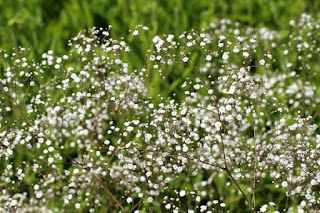Baby's Breath Flower
Baby's Breath Flower
Kingdom = Plantae
Division = Magnoliophyta
Class = Magnoliopsida
Order = Caryophyllales
Family = Caryophyllaceae
Genus = Gypsophila
Species = paniculata
Gypsophilia plants grow 1 to 2 feet, bearing a profusion of white or pink flowers. The stems separate into many branches, giving it a light appearance, perfect for accenting bouquets. Gypsophila lasts long up to a week and dries well. Baby's Breath is very much suitable for borders combined with other perennials.
Facts of Gypsophilia
- Gypsophilia is distributed throughout the Northern Hemisphere.
- Most commonly known as "Baby's breath", the tiny gypsophilia flower is produced on numerous, fragile stems and is most commonly used a filler, but is widely enjoyed as a dried flower, especially as an accent at Christmas.
- Gypsophilia is available year round.
- "Baby's Breath" is available in either pink or white varieties. Perhaps the most popular variety is called Million Star. Two other varieties commonly found are New Love and Party Time.
- Gypsophila is primarily used as a fill er flower to accent greens and fill voids between flowers.
- Baby's Breath makes a very nice dried flower that can be used to decorate any thing from wreaths to craft projects.
- The dainty flowered Gypsophila is commonly used in floral arrangements and gypsophilia plants bring beauty to the garden when grown in clumps.
Varieties of Gypsophilia
- Gypsophilia elegans = Tall annual summer flower with clouds of tiny blooms.
- Gysophilia Muralis = Annual plant types for borders and bedding.
- Gypsophilia paniculata (Baby's Breath) = Perennial variety with tall, multi-branched stems and clusters of tiny, delicate flowers, which can be good filler in bouquets.
- Gypsophilia repens = Low-growing perennial trailing plants for borders and rock gardens.
Propagation of Gypsophilia
Seeds are the main means of propagation for Baby's Breath. You can directly sow the seeds of Gypsophilia into your flower garden or start indoors for a jump start on the year. Sow them after the soil has begun to warm in the spring. Baby's Breath do not like frost, so if started indoors, transplant them outdoors after the last frost date. Space plants eight inches apart.
How to Grow Gypsophilia
- Baby's Breath like full to partial sun.
- They prefer rich, light soils, and are not fond of clay.
- They also do not like dry conditions. Their rapid growth demands that they are watered during dry periods.
- Add a general purpose fertilizer before planting if the soil is poor.
- Once your Baby's Breath germinates in 10 to 15 days, they will grow rapidly. For a continuous bloom, plant them in succession every two to three weeks.
- Insect and disease problems are not too common. If insect or disease problems occur, treat early with organic or chemical insect repellents and fungicide.
Gypsophilia Plant Care
- Place 4-8 inches of cool water in a clean bucket and add preservative according to the manufacture's instructions on the package. (Use warm water -at most 100 F -if the buds are tight , in order to promote more rapid opening.)
- Remove the gypsophilia from its sleeve and fluff the bunches for better air circulation.Cut the stems 2 inches and place in the solution.
- Avoid overcrowding the bucket, placing approximately 4-6 bunches per bucket after fluffing.
- Keep the flowers away from sources of ethylene gas such as ripe fruits and decaying plant material. Sources of carbon monoxide must also be avoided.
- Sensitive to heat, drafts and other drying environments.
- After two days in the solution, place the flowers in clean water. This water should be changed every day and the stems should be trimmed approximately 0.5 inch every two or three days to promote longevity.
- Baby's -Breath is ethylene- and water-stress sensitive. Water stress can rapidly induce ethylene production and thereby reduce flower life. In short, do not allow flowers to dry (inside or outside coolers), as shorter life will surely result.
Source : https://www.theflowerexpert.com/content/mostpopularflowers/morepopularflowers/gypsophilia

Komentar
Posting Komentar